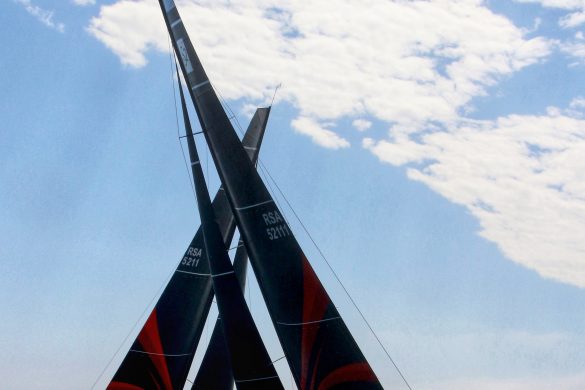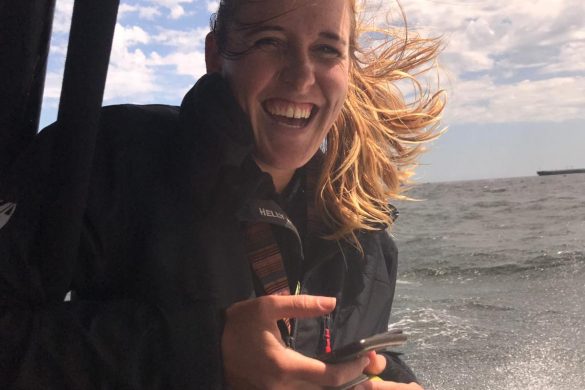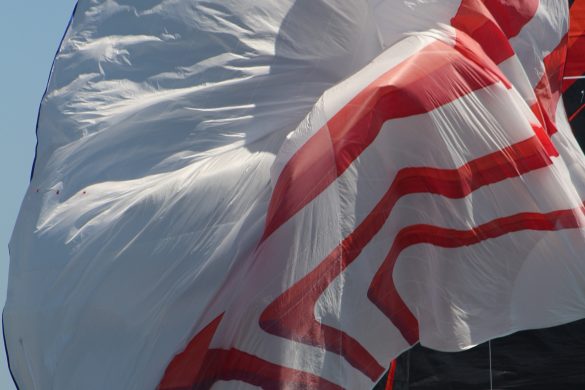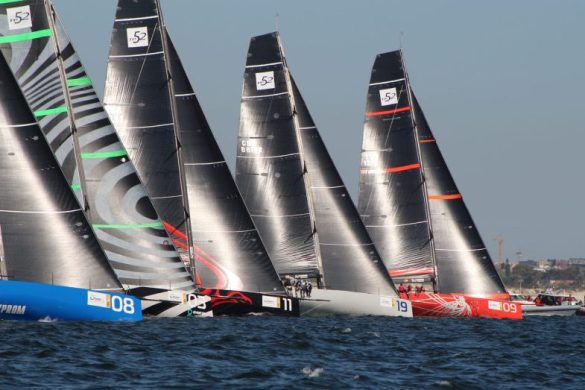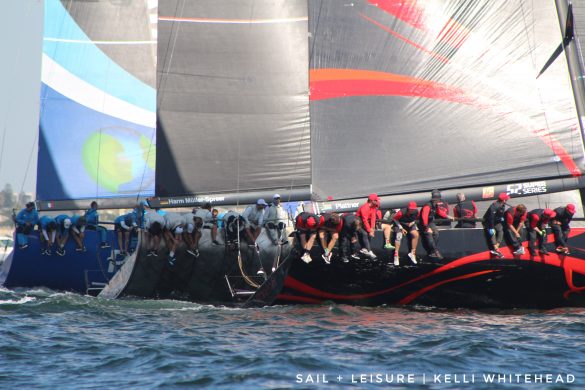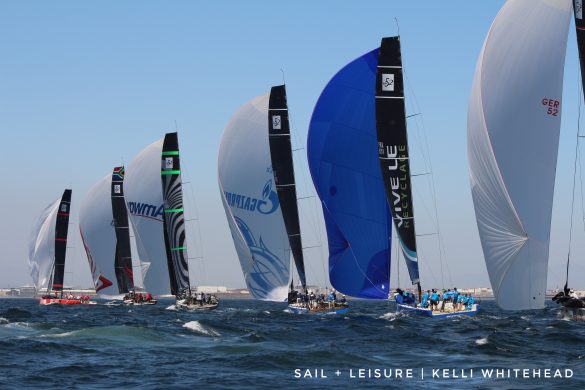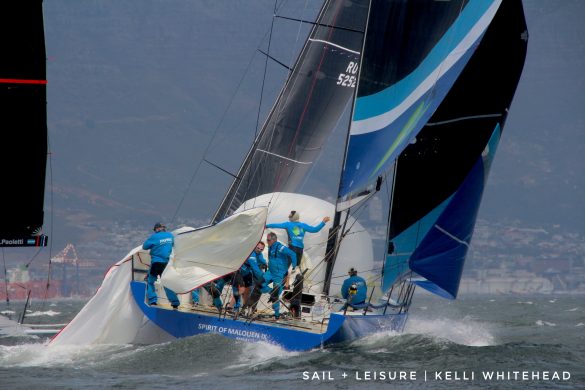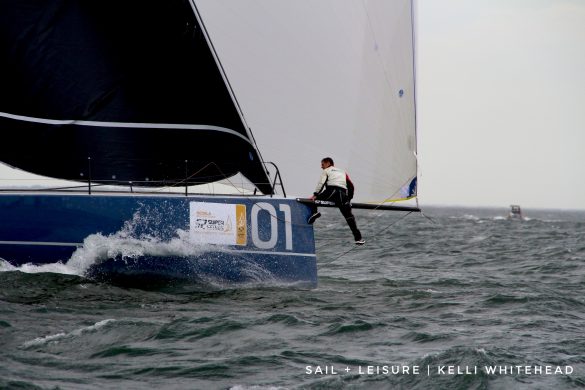Sail + Leisure’s Marketing and Publishing Co-ordinator, Kelli Whitehead, shares her experiences on the media boat for the Odzala Discovery Camps 52 SUPER SERIES V&A Waterfront – Cape Town.
There are not many feelings that come close to the one you get looking through a lens at the bow of a TP52 coming straight towards you. But I can assure you, when you suddenly can’t zoom out anymore and the boat is very much still aimed at you, you’ll know you’re in for an adrenalin rush.
The 52 SUPER SERIES was in town and as a young media professional who is mostly self taught in her craft, I was able to get a glimpse into the life of a professional yacht racing photographer for the first time. When Ingrid Hale, our Publishing Editor-in-Chief, asked me to fill in the media accreditation forms and waivers I had no clue what to expect from the experience. I was there to cover the racing for our social media platforms, including posting live updates onto our Facebook and Instagram stories. I was not going to let the opportunity to get some epic shots pass me by, so I took my Canon 650D and kit-lens set along for a ride.
On day 1 of the event I was busy with my Weekend Wrap-up report, which meant that I would be watching the racing on the tracker for the day. When day 2 swung around I was beyond eager, arriving at Jetty 2 an hour before dock off for the race boats at 10:30.
I was non-the-wiser to the fact that our media boat was not going to be fitted with the normal two-stroke motor on a recreational fishing/ski-boat type vessel that I was used to. So when Dan Nixon, from 52 SUPER SERIES, pointed down the dock and said “That black one on the end is yours” I couldn’t help but beam with excitement. Our steed for the week was a sleek, high speed rib from Gemini Marine with two 150hp four-stroke engines and ample room for 6+ guests. Now I was getting excited.
After a brief introduction to our skipper Myck Jubber and the other photographers onboard we set off to the race course in Table Bay. On board with me were some of sailings most accredited photographers. Ingrid Abery, Max Ranchi and Rick Tomlinson have all been to the world’s top sailing events rubbing shoulders with the yachting elite and photographing the top of the top sailors for years. Needless to say I was just a little star struck.
The procedure to capture the best images seemed to fall into place easily for the team and our skipper, a clear indication of how many times they have been here, done this. So just before the first start gun went off Max and Ingrid advised where the boat should be positioned to get the best shots, and once that start gun went off it was all stations go! Everyone was crouched behind their lenses to catch that perfect down the line shot. After a quick check from Myck that we are all pleased with ours shots we raced off to catch the TPs as they screamed up the course to the top mark.
The incredibly high level of sailing at this event meant that we had to follow some rules and restrictions of where the media boat could be on the course. Naturally, we were not allowed to cross in front of the boats, get too close to them or interfere in their course of sail. We had a few occasional close calls with the boats and some waving hands from racing teams or umpires to get out of the way. But of course we pushed it as close as possible.
Mark roundings are a sure way to capture on-board action and beautiful spinnaker hoist and drop action. The courses set by Race Officer, Maria Torrijo consisted of a limit-mark and windward mark with an offset at the top of the coarse and a gate at the bottom of the course.
At the windward marks Max and Ingrid seemed to favour choosing to sit on the opposite layline of the limit mark and the windward mark to capture the boats as they tack over and prepare for the offset spinnaker hoist. This position alternated with sitting just up from the offset mark, a prime spot to catch the last rush before the hoist, and stunning down-the-line shots of the fleet with their bags flying.
On the second day of racing we got a little cheeky and placed ourselves within the triangle of the three top marks. This was an incredibly close position to capture the sailors in action as the teams fight for position. However, this was the first of many instances when we got flapping arms and grumpy shouts from the race teams and umpire boats, so we didn’t attempt it again.
After the boats roared passed us and everyone was happy with their shots we hastily put the cameras away before zooming to the bottom gate, spun the boat upwind, and prepared for the bottom mark rounding and spinnaker drop. This was always a fun guessing game of which mark the teams would choose to round and sparked some good conversations onboard. Some times we opted to rather chase the boats all the way down the course, getting as close as we could to capture the intensity of each team’s concentration. But this was how we got the angry flapping arms from Provezza… and Platoon… and Quantum Racing.
Having experienced this kind of high-intensity, fast pace creativity I can honestly say I have learnt an incredible amount of respect for the people working in the sport photography industry. The importance of respect and creative sharing was clear right from day one. Being onboard a rib with 3 -5 other photographers all taking pictures of the same subject I realised very quickly the level of respect amongst them. No one got in the way of the other or tried to sabotage a shot. If someone wanted to chase a certain race team or stop whilst blasting down to the marks, no one argued. It was amazing to experience the camaraderie between them. I would think in a lot of other creative situations people could become stingy and try to take up all the space for themselves.
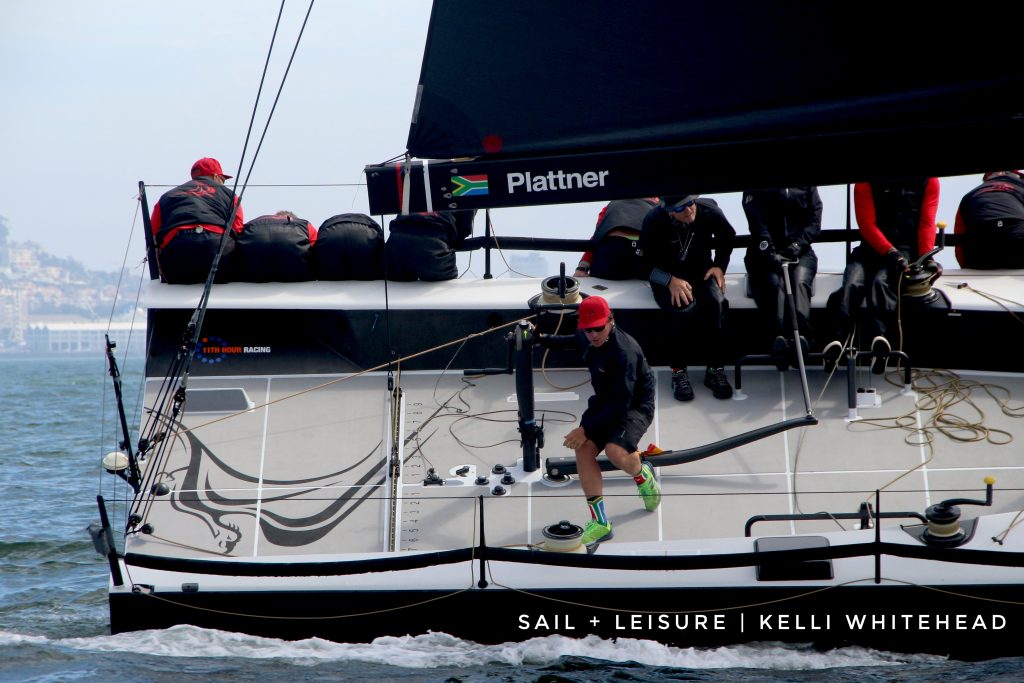
The Phoenix (12) Action shots on board after an upwind tack – Odzala Discovery Camps 52 SUPER SERIES V&A Waterfront Cape Town 2020 ©Kelli Whitehead
Getting the best shot often comes down to how you to talk to your skipper. The photographers onboard trusted Myck to know how to get into position and out of the way when needed. They clearly explained where they wanted to be, made sure everyone else was good with the decision and then left it up to him. Knowing where to put the media boat is step one to making sure you get a good shot, something that seems obvious but is also something that comes with years and years of experience on the water.
Salt water and sea air are not good friends of any camera, but when this is the job you really don’t have much choice. I made sure to avoid any splashes as best as I could to the lenses, but learnt very quickly that having a lens cloth was essential. Both Ingrid and Max normally use hard case waterproof camera boxes and Rick had a fully waterproof camera bag which housed his equipment especially when we were speeding around the course. Although, for this trip Ingrid couldn’t travel with her camera case and simply used a Coleman cooler-box with towels inside for her cameras – genius! After the racing each day I made sure to wipe down the body and lenses of my camera with a slightly damp cloth to try get rid of the majority of the salt. Note to any and all newbies – do not change lenses when you’re on the water! Choose one and stick to it, you do not want salt water on the internal mirrors.
The other essential item is good foul weather gear! Tearing around the course, even in flat conditions proved to be a wet affair. I was extremely thankful to have my Helly Hansen gear to stay dry. I spent the majority of day 4, which saw a strong South East wind gusting 28 knots, with my back to the wind, clinging to the cockpit with my camera inside my jacket.
This experience was definitely one I will always remember. The fast-paced energy with some ‘hurry up and wait moments’ kept me on my toes as I realised you can’t stop focusing in case you miss the moment of the day. The opportunity to be out on the water with top athletes and photographers doing what they do best will always stay with me. Needless to say the bug has bitten and I cannot wait to get out on the water again and capture more shots.


